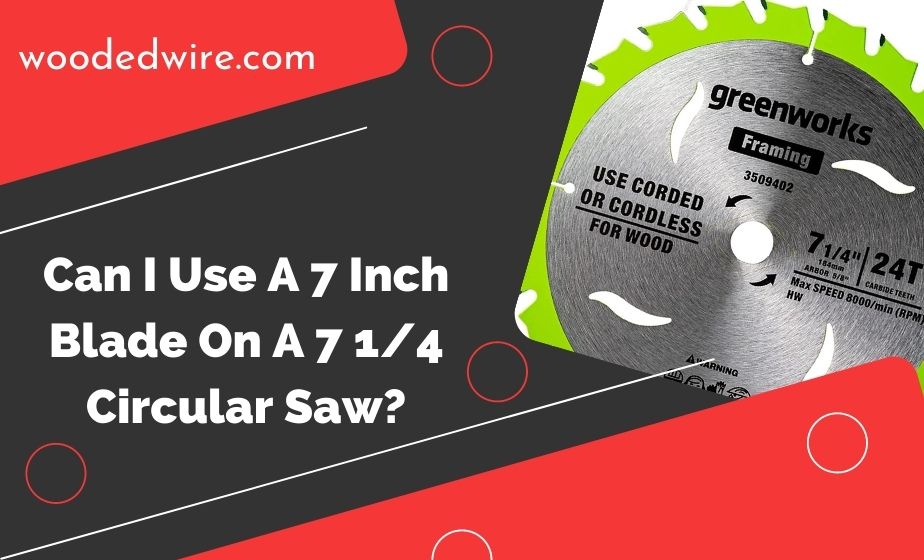It is a common tendency that people usually do not give importance to small things. But small things can also do a bigger job. Moreover, small things have the right to get importance because sometimes there is much more to know about a smaller object.
However, I used to see smaller objects in an unimportant way. But now I know the significance of smaller things because I got my success through a tiny part of a circular saw.
As you know the name of a circular saw, you may ask, “Can I use a smaller blade on my circular saw?” Undoubtedly it is an important question. To know the answer, please read the entire article.
Basic Ideas Regarding Circular Saw
Although various tools are available for cutting things, the circular saw is the most practical. It has an electric motor that rotates a round blade quickly, allowing users to quickly cut through tough lumber, plywood, and other materials.
Crosscuts and length cuts are both quickly and precisely made by circular saws. You can use circular saws in bevel cutting. A circular saw typically has the following parts:
- The blade guard is a part of a circular saw. It can retract to reveal the blade when the saw is in use and covers the blade when the saw is not in use.
- The plate is another part of the circular saw. It keeps the saw steady against the workpiece.
- Depth adjustment is an important part of a circular saw. It allows objects with various widths.
- Bevel adjustment is another part of a circular saw. It enables the plate to slope concerning the blade for bevel cuts.
The diameter of the saw blades is typically used to categorize circular saw sizes. The most typical range of sizes is from 5-½” to 7-¼”.
Circular saws come with a wide range of options as well. You have to select the ideal circular saw for your unique requirements.
Circular Saw Blades of Various Types
You have now learned about the basic ideas of a circular saw, like what it is and its parts. In this section, you will learn about the various types of blades of a circular saw. The common blades you can use with your circular saw are listed below:
Blades for Ripping
A ripping blade on a circular saw is the most effective blade to use when ripping hardwood. It is specifically designed to cut throughout the length of the wood fibers, leaving a cleaner border.
A ripping blade typically has between 14 and 24 teeth. It contains a huge gullet, allowing it to handle a variety of materials for rip cutting. This blade is the most suitable choice if you need quick and harsh cuts.
- Plywood or Lumber Blade
The ideal blade for cutting plywood should have more teeth because plywood is prone to splintering and chipping. A plywood blade has 40 teeth or more than that. It is designed for fine materials because cutting wood with it will result in less splintering.
- Blade for Crosscutting
Crosscutting is more difficult than rip cuts since it involves cutting through more wood fibers. A crosscutting blade produces a cleaner cut because it has numerous tiny teeth and a shallow gullet.
Since they have numerous teeth, crosscut blades can provide greater friction when cutting wood. They also cut more thoroughly than rip cutting.
Additionally, the wood content of these blades will be lower, resulting in an extremely smooth surface. However, these blades can give your object burn marks because it works slowly and takes time.
- Blade for Finishing
You can use a finishing blade to create a smooth and tidy cut on the wood’s surface. You must use this blade if a specific area is left exposed after finishing the job. A blade of this kind can cut wood without harming it since it has many teeth.
- Blade with A Thin Kerf
In actuality, “kerf” refers to the width or size of the cut. The purpose of thin-kerf blades is to cut dimensional timber and make precise cuts in wood.
Never forget that you should not use thin-kerf blades to cut harder wood. Due to its extreme thinness, it will undoubtedly flex, making it very challenging to cut the hardwood in a straight line.
Circular Saw Teeth of Different Types
Now you know the variety of circular saw blades. In this section, you will learn about the variety of circular saw teeth. Various types of circular saw teeth are given below:
Related Article: Best Circular Saw Under $150 And $75
Related Article: Best Circular Saw With Electric Brake
- Alternative Top Bevel Teeth
When switching between left-hand and right-hand bevels, the bevel design of these teeth might be helpful. It is suitable for natural timbers because it can handle the hardest materials. Crosscut blades are ideal for this type of tooth structure, though you can also use them for light rip cuts.
- Hook Angle That Is Negative
The backward-flanking tip of the teeth slows the feed rate. Additionally, it can make the circular saw blade safer for the user by lowering the possibility of kickback. Radial arms and miter saws would be ideal for this kind of blade.
- Teeth That Is Nail Resistant
These are the perfect teeth to use if you want to destroy strong material. As you can find this particular blade on most construction sites, it is frequently referred to as ‘demolition timber.’
You can even break a standard saw blade with nail-resistant tooth blades due to its exceptional toughness. Nail-resistant tooth blades are softer carbide, which can easily withstand stress or shock.
Using A Smaller Blade on Circular Saw
Circular saw blades can be larger and smaller. It is important to know, “Can I use a smaller blade on my circular saw?”
In this section, you will get the answer to it. But first of all, you will have to consider some important points.
Important Points of Consideration
The steps you must take before selecting a smaller blade and utilizing it to cut material are listed below:
- Go Through The Instruction Book
Each circular saw comes with instructions on what size blade you can use. The instruction book will assist you in assessing whether a smaller blade suits your circular saw perfectly. Undoubtedly, it will serve as your greatest guidance when selecting a circular saw blade, regardless of the type or size.
- Keep The Blade’s Use in Mind
The answer to your question is yes, you can use smaller blades in your circular saw, but can you operate the machine properly? You must think carefully about the kind of material you are going to cut.
Even while the circular saw might be able to handle the blade size, the blade itself might not be as good at cutting the material. Additionally, before using a blade, note the cut you want to make.
You may not be able to get the cut you want with some blade sizes. You can choose the ideal type of blade to use based on the cut type.
- Always Make Adjustments to Settings
Once you utilize a smaller blade, you must constantly be ready for the decreased cutting depth. Adjust as needed because some materials would undoubtedly not work with the default settings. It is particularly true when using smaller blades to cut bulky materials.
How Should I Choose A Blade for My Circular Saw?
To choose a blade that will operate well, you must understand how to choose the proper blade for your saw. Here are a few ideas for you to think about.
- Material Types
As previously stated, you must consider the type of material you will be cutting while selecting a blade for your circular saw. Make sure you know the material you will be working with because different blades are available for wood, metal, and plastic.
- Kind of Job
The job you plan to complete can also influence the blade you select. A general-purpose blade is one type of blade you can buy and use for various tasks.
But you can use a specialized blade for a particular task if you need a more precise cut. Your decision will impact how quickly and effectively you do your job.
- Cut Types
A circular saw can be used to make various cuts, but the kind of cut you get will depend on the blade you are using. A crosscutting blade can make things more precisely and smoothly, while a ripping blade can quickly and roughly cut things.
Frequently Asked Questions
Is A Circular Saw Better Off With More or Fewer Teeth?
A circular saw is better with more or fewer teeth because blades with more teeth produce a smoother cut and better finish, whereas blades with fewer teeth generally cut through materials more quickly.
What Is A Saw Blade With 60 Teeth Used For?
A saw blade with 60 teeth is used for cleaner cuts.
What Is The Most Common Diameter of A Circular Saw?
The most common diameter of a circular saw is 7-¼ inches.
To cut Laminate, How Many Teeth Are Required?
80 to 100 teeth are required to cut laminate.
What Is The Best Saw Blade to Rip Through A Hardwood Floor?
A rip blade is the ideal saw blade to rip through a hardwood floor.
What Is The Lifespan of A Circular Saw Blade?
Depending on the material being cut and the quality of the blade, the lifespan of a circular saw blade is from 12 to 120 hours.
Final Thoughts
Now you know the importance of smaller things because you have read the article. You also got to know some other important information about the circular saw.
Moreover, there was one question you asked. The question was, “Can I use a smaller blade on my circular saw?” Now you know the answer to this question: you can use a smaller blade on your circular saw.



